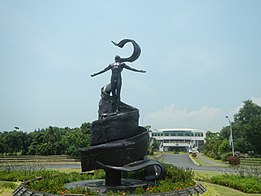University of the Philippines Open University
 From Wikipedia - Reading time: 12 min
From Wikipedia - Reading time: 12 min
Unibersidad ng Pilipinas (Filipino) | |
 | |
Other name | UPOU, UP Open University |
|---|---|
| Motto | Honor, Excellence, Service [1][2] |
| Type | National Public research university, Open university |
| Established | February 23, 1995 |
Academic affiliation | ICDE, AAOU, APRU, CODEPP |
| Budget | ₱194.977 million (2019)[3] |
| Chancellor | Melinda dP. Bandalaria, PhD |
| President | Angelo Jimenez |
| Vice-Chancellor | Maria Rowena D.R. Raymundo |
Total staff | 346 (2019)[3] |
| Students | 4,086 (2019)[3] |
| Undergraduates | 841 (2019)[3] |
| Postgraduates | 3,245 (2019)[3] |
| Location | , , 14°10′26.3″N 121°15′45.3″E / 14.173972°N 121.262583°E |
| Campus | Virtual campus |
| Language | English |
| Hymn | "U.P. Naming Mahal" ("U.P. Beloved") |
| Colors | |
| Website | www |
The University of the Philippines Open University (UPOU) is a public research university and is the fifth constituent university of the University of the Philippines System.[4] The majority of UPOU students are based in the Philippines but all of its programs can be taken anywhere in the world. While primarily a virtual university, it has a physical campus that houses admin and faculty offices in Los Baños, Laguna, with Mega Learning Hubs (MLH) in Manila and Cebu.
UPOU was established in 1995 by the UP Board of Regents as the evolution of the UP Distance Education Program. UPOU offers accredited graduate and undergraduate degrees as well as diploma courses and Professional Teaching Certificates (PTC) to Filipino and international students in more than 70 countries.[5] It also offers MOOCs on various subjects through its official platform, Massive Open Distance eLearning (MODeL), and hosts its degree programs through its official student portal, MyPortal, both learning platforms were developed using a free and open-source learning management system called Moodle.
As of 2019, UPOU had 4,086 students enrolled in various programs representing 7.3% of the student population of the entire University of the Philippines system.[6] This makes it the 4th largest constituent university by student population after UP Manila, and just slightly more than UP Visayas, which had 7.2%, while having the smallest budget of any constituent university.[7]
UPOU was declared the National Center of Excellence in Open Learning and Distance Education by the Commission on Higher Education and is the leader of the Consortium of Open Distance Education Providers in the Philippines (CODEPP) and a member of the International Council for Open and Distance Education (ICDE).[8][9]
History
[edit]University of the Philippines Open University was established on February 23, 1995, as the fifth constituent university of the University of the Philippines System.[10][11] It is mandated by Republic Act No. 10650, also known as the Open and Distance Learning Act of 2014, to assist the Commission on Higher Education (CHED) and the Technical Education and Skills Development Authority (TESDA) in their open distance learning functions.[12]
Academics
[edit]
The U.P. Open University delivers its programs and courses through distance education (DE). Learners study through independent self-learning using specially designed learning materials and resources. Teaching and learning are mediated through the use of technology like print, audio, video and the internet. Students interact with their instructors and their peers through virtual classrooms, SMS, email, and web conferencing. Almost all courses are offered through online learning mode.
In January, 2024, UPOU is offering free 24 Massive open online courses which cover various categories, including "ODeL teacher accreditation, child rights protection, technology for teaching and learning, educational media production, sustainable development, business analytics, introduction to distance education, and more."[13]
Faculties
[edit]- Faculty of Education (FEd) covers the following range of areas of study: general education, alternative education, language and literacy education, science and mathematics teaching, social studies education, and distance education.
- Faculty of Information & Communication Studies (FICS) offers degree programs in communication, information systems, computer science, and multimedia studies.
- Faculty of Management and Development Studies (FMDS) offers a range of postgraduate programs in R&D management, environment and natural resources management, land valuation and management, public management, social work, nursing, hospital administration, and public health as well as non-formal programs in entrepreneurship, health, and land valuation.
Research
[edit]UPOU conducts academic research in its various faculty disciplines, in addition to its associated research into the best practices in global distance education. Research in this area has delved into the following topics: DE learner profile, learning styles, and learner performance; online teaching and learning; virtual learning environments; computer-mediated collaborative learning; gender and distance education; pedagogical approaches in distance education; DE program evaluation; and management of DE.
In addition, the university has also pursued research in the following discipline-based areas: education, information and communication technology; multimedia, communication, organization and management; public policy, environment, health, and development studies. Many of these discipline-based studies have been externally funded.
Learning centers
[edit]This article contains promotional content. (November 2021) |
The U.P. Open University has several learning centers located in other U.P. campuses and state universities in selected regions of the country. These centers are the venues where students can conduct and seek advice on transactions, activities and procedures regarding application for admission, registration, student orientation, distribution of course materials, dropping of subjects, filing leave of absence, examinations, accessing library materials, face-to-face tutorials (if available) and tutorials on basic computer and internet literacy. The university also has a virtual learning center, where all transactions and procedures are conducted and communicated online.
Headquarters
[edit]This article contains promotional content. (November 2021) |
The U.P. Open University Headquarters is located in Los Baños, Laguna, close to the International Rice Research Institute. Its main administrative and annex buildings house the main offices of the university, including the Office of the Chancellor (OC), the Office of the Vice Chancellor for Academic Affairs (OVCAA), the Office of the Vice Chancellor for Finance and Administration (OVCFA), and the Faculties of Studies Offices. The Centennial Center for Digital Learning (CCDL) Auditorium is also in this complex.
A major landmark in the UPOU Headquarters is the U.P. Open University Oblation sculpture that stands in the Oblation Plaza in front of the main building. UPOU's Oblation stands on a pedestal with a ribbon-like flag swirling around the pedestal and the Oblation. This gives the effect of the flag lifting the Oblation into greater heights and gives it the boundless reach that is symbolic of UPOU's prime objective of widening access to UP quality education. It was designed and executed by University Artist and UPOU Chancellor Dr. Grace J. Alfonso in 2005. The Oblation Plaza is also where the annual commencement exercises are held.
The university also maintains a satellite office at the National Computer Center Building in Diliman, Quezon City. In the future, the university will move to a new campus in New Clark City in Capas, Tarlac.[14]
Academic affiliation
[edit]UPOU maintains membership in the follow local and international academic associations:
Local
[edit]- Philippine Society for Distance Learning (PSDL)[citation needed]
International
[edit]- International Council for Open and Distance Education (ICDE)[8]
- Asian Association of Open Universities (AAOU)[15]
- Association of Pacific Rim Universities (APRU)[16]
Notable alumni
[edit]- Jejomar Binay - Diploma in Environment and Natural Resource Management graduate.[17] Former Mayor of Makati and former Vice President of the Philippines.
- Migz Zubiri - Graduate, Master in Environment and Natural Resources Management.[18] Former Senate President of the Philippines and former Bukidnon 3rd district representative.
- Sarah Geronimo - Graduate, Associate in Arts.[19] Singer.
- Cathy Untalan - Diploma in Environment and Natural Resource Management.[20] Beauty pageant.
See also
[edit]Notes
[edit]References
[edit]- ^ Acebuche, Yoniel (May 14, 2024). "UP president Angelo Jimenez unveils university's new motto: 'Honor. Excellence. Service'". The Philippine Star. Retrieved May 15, 2024.
- ^ Iskomunidad (n.d.). "University of the Philippines System". Archived from the original on September 13, 2021. Retrieved September 14, 2021.
- ^ a b c d e "U.P. Statistics 2019" (PDF). University of the Philippines System Budget Office. Retrieved July 26, 2021.
- ^ "About". University of the Philippines Open University. Retrieved November 8, 2021.
- ^ "About". University of the Philippines Open University. Retrieved November 8, 2021.
- ^ "UP Statistics for CY 2019" (PDF). University of the Philippines System Budget Office. 2019. p. 83. Retrieved November 7, 2021.
- ^ "UP Statistics for CY 2019" (PDF). University of the Philippines System Budget Office. 2019. p. 219. Retrieved November 7, 2021.
- ^ a b "UPOU - ICDE Member". International Council for Open and Distance Education. Retrieved November 7, 2021.
- ^ superadmin (August 25, 2022). "Meet CODEPP: The New Consortium that will Push Forward Open Distance eLearning in Ph". University of the Philippines Open University. Retrieved April 20, 2023.
- ^ Jung, Insung; Latchem, Colin (April 5, 2012). Quality Assurance and Accreditation in Distance Education: Models, Policies and Research. Routledge. ISBN 9781136849862. Retrieved January 20, 2017.
- ^ "R.A. 9500 AN ACT TO STRENGTHEN THE UNIVERSITY OF THE PHILIPPINES AS THE NATIONAL UNIVERSITY". www.lawphil.net. Retrieved January 20, 2017.
- ^ "Republic Act No. 10650 | GOVPH". Official Gazette of the Republic of the Philippines. Retrieved January 20, 2017.
- ^ Mabate, Angela (January 16, 2024). "Here's the list of 24 free online courses from UP Open University". Manila Bulletin.
- ^ Lontoc, Jo Florendo B. (December 12, 2022). "Construction underway on UP New Clark City". University of the Philippines. Retrieved January 9, 2023.
According to Concepcion and Zamora, UP-NCC is designed to be the main headquarters of the UP Open University and satellite sites of the UP Manila PGH, the National Institutes of Health and the College of Medicine, and the UP Diliman College of Engineering.
- ^ "AAOU Full Members". Asian Association of Open Universities. Retrieved November 7, 2021.
- ^ "APRU Members". Association of Pacific Rim Universities.
- ^ Singcol, Anna Katrina T. "Profile of Jejomar "Jojo" Cabauatan Binay". ABS-CBN News. Retrieved January 23, 2017.
- ^ "Senator Juan Miguel F. Zubiri". Senate of the Philippines. Retrieved January 23, 2017.
- ^ "Sarah G wants to return to school". ABS-CBN News. April 15, 2015. Retrieved February 1, 2023.
- ^ Solitario, J (March 5, 2018). "From Iska to Beauty Queen". University of the Philippines. Retrieved February 1, 2023.
External links
[edit] Media related to University of the Philippines Open University at Wikimedia Commons
Media related to University of the Philippines Open University at Wikimedia Commons- Official website
 KSF
KSF

